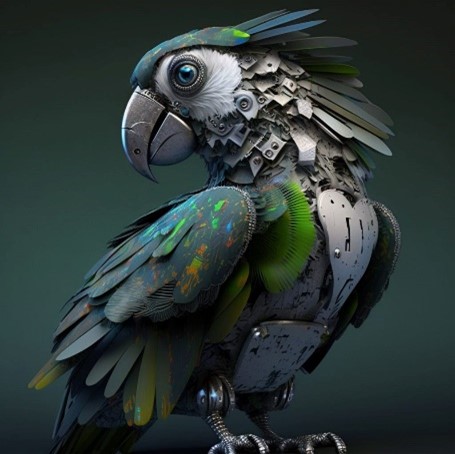
Newsletter March 2023: Teaching and learning with AI
In this newsletter we focus on the current debate on artificial intelligence (AI) and what it means for SDU as an educational institution that AI software such as AI chatbots has become more user-oriented and easily accessible.
Since ChatGPT was launched as an experiment from the company OpenAI in November 2022, several AI chatbots have made daily headlines in the media, such as 'Chatbot scores tens in tests' and ‘The AI chatbots are coming for your exam paper’, and Danish universities have almost overnight been forced to relate to these new forms of AI software. All Danish universities have initially chosen to ban the use of AI chatbots at exams, both with and without aids. At SDU, students are informed "that it is not allowed to use chatbots, including "ChatGPT", in connection with exams and teaching, unless their use is specifically listed as a direct part of the exam or teaching".
However, there is broad agreement among Danish universities that banning is a short-term solution and not the way forward. Technologies that AI chatbots are based on will become a natural part of our everyday life in the future, and the latest developments in artificial intelligence are a good reason to rethink both exams and learning in the world of education. SDUUP continuously collect resources and follows the debate about AI's potential and challenges within teaching and learning. In the following, we give an insight into what is particularly important in the debate at the moment and, in conclusion, reference is made to interesting resources which can be pursued.
Teaching and learning with AI
AI has long been used in educational contexts for, among other things:
- adaptive learning, where materials and pace are adapted to the individual student's academic prerequisites
- to measure, collect, analyze, and provide immediate and automated feedback
- to inform the design of courses and study programmes
- to provide professional support (teaching and personal learning assistants)
- to support better learning experiences for students with special needs
However, the use of AI chatbots in education comes with a price. In a blog post for IT-torvet.dk, Mikala Hansbøl, a senior researcher at UCL, has formulated nine points of attention that educational institutions should carefully consider before they start experimenting with the use of AI products, such as chatGPT, in their teaching. For example, educational institutions must be aware that ChatGPT is a commercial product which is not free to use, as users pay with their data.
In her blog post Mikala Hansbøl also points out that describing something is actually a very special human ability. We should practice that ourselves rather than leave it to a technology that cannot move around in the world, among us humans, or move around in nature and sense and recognise in diverse ways, what there is to describe.
Mikkel Flyverbom is Professor of Communication and Digital Change at CBS. In a statement to Djøfbladet he stresses the importance of AI chatbots not becoming too dominant, so that the students completely lose the ability to remember, apply theories and adopt a reflective and critical attitude.
The same concerns about the negative impact of AI chatbots on teaching and learning are encountered in the upper secondary school. In an article for gymnasieskolen.dk, Tomas Kepler, chairman of the Secondary School Teachers' Association, expresses, among other things, a huge concern that you can no longer ensure general education at the high schools when the work is left to a robot. High school students' learning suffers when they themselves do not relate to the process involved in working with the task. “…it inhibits the way we develop as human beings – the way we develop our critical thinking, artistic sense, and moral compass. This is the essence of what we work with in upper secondary education", says Tomas Kepler.
 Caption: ChatGPT is compared to a stochastic parrot, that repeats what it has read/heard with a certain probability. Source: Blinded by Analogies by Ethan Mollick.
Caption: ChatGPT is compared to a stochastic parrot, that repeats what it has read/heard with a certain probability. Source: Blinded by Analogies by Ethan Mollick.
On the other hand, Professor Kristoffer Laigaard Nielbo, who researches artificial intelligence at AU, is impressed by the way in which the chatGPT is able to enter into a conversation with a human being. He is not too worried about the consequences of using it, both in teaching and for exams with all aids within his field of expertise. In an interview with Omnibus, he states that he sees it as a valuable tool for students, where it can be used as a kind of dialogue partner to reflect on an assignment, as long as the students are aware of chatGPT's limitations.
Luís Cruz-Filipe is Associate Professor in artificial intelligence at the Department of Mathematics and Computer Science at SDU and head of education at SDU's new bachelor's program Artificial Intelligence. In a news article on sdu.dk – What is artificial intelligence? he goes into more detail about the limitations of AI systems in relation to humans. He says that "most AI systems we encounter are limited by the data and input they are trained on, while humans can draw on a much wider range of experience and knowledge.
This means that artificial intelligence may have difficulty making decisions or predictions in situations it has not previously faced. Likewise, these AI systems also have a more limited creativity. Because although AI systems can generate new ideas and solutions based on the data it is trained on, they cannot "think outside the box" or come up with completely original ideas in the same way that humans can". Luís Cruz-Filipe also highlights data protection and privacy concerns because AI systems can collect and analyze large amounts of personal data. It is also important not to blindly trust the AI systems and to be aware of the biases and prejudices that the AI system may develop during its training.
AI at SDU
Based on the above features in the debate on AI, SDU is faced with a major task of incorporating AI into our existing teaching and examination practices at the university in a sound manner that is in line with our pedagogical principles and values.
At SDU, Prorector Helle Waagepetersen has taken the initiative to put AI on the agenda in order to have a more structured and unified approach to AI at SDU. It should not be left to the individual employee to uncover the opportunities and handle the challenges of AI. Many people at SDU already focus on AI – both within research, teaching, and administration – so in the first instance it is about gathering and drawing on the experience we already have in order to further uncover the area.
Several teachers have already gained experience in integrating artificial intelligence in their work. For example, Jacob Fredegaard Hansen, who is a data scientist at the Department of Biochemistry and Molecular Biology (BMB) at the Faculty of Science, sees both potentials and challenges in the use of artificial intelligence. Read about Jacob's perspectives on the use of AI in his daily work.
The aim is digitally competent students
The intention of integrating AI technologies into the existing teaching and examination practice is to educate digitally competent students who
- Can be critical of information/misinformation
 Caption: However, it is getting harder and harder to spot fake photos and videos. The image generator Midjouney has, among other things, been used to spread images on Twitter of Donald Trump being arrested (Source: DR news)
Caption: However, it is getting harder and harder to spot fake photos and videos. The image generator Midjouney has, among other things, been used to spread images on Twitter of Donald Trump being arrested (Source: DR news)
- are aware of the role of the tech giants and the bias that will inevitably be there
- are ethical and conscious consumers of digital technologies – they must not only understand technologies, but also learn to be able to work with digital technologies in creative and innovative ways
SDUUP is available with tailored activities to help in the process of thinking AI into teaching and exams and is happy to hold workshops with a focus on e.g. restructuring/adaptation of/inspiration for exam forms, where AI chatbots come up short. Just write to sduup@sdu.dk.
If you want to know more ….
Introduction to the the field of Artificial Intelligence (AI)
- Malte von Sehested, teacher and Master in it, learning and organisational redeployment, as well as initiator of IT-Torvet.dk, gives in his video an informative and very pedagogical introduction to the field of artificial intelligence, which he himself describes as a large and thus also a difficult area to define briefly and precisely.
Keywords: #KunstigIntelligens, #MachineLearning,#NeuraleNetværk, #DeepLearning, "SuperviseretLæring, #UsuperviseretLæring, #ForstærkningsbaseretLæring, #SprogmodellenGPT-3, #AlphaFold, #EksemplerAIBias, #EksemplerAIBrug.
AI in Higher Education – Contact North’s web pages about AI on all higher education in Canada
AI and writing
Tine Wirenfeldt Jensen holds a PhD in learning and education. In this article in the journal Gymnasieskolen Tine gives good advice for teaching in a time with ChatGBT and addresses the problem by banning the use of ChatGPT in the upper secondary school. Tine also gives presentations on ChatGPT and writing in upper secondary school.
- In this context Tine Wirenfeldt Jensen refers to this article:
- Fyfe, P. (2022). How to cheat on your final paper: Assigning AI for student writing. AI & Society, https://doi.org/10.1007/s00146-022-01397-z. The article gives an idea of how to become even more critical of artificial intelligence by including it in teaching. The article also contains many examples of how artificial intelligence can be included in assignment writing.
AI and exam
- Mollick, E. R. & Mollick, L., (December 13, 2022). New Modes of Learning Enabled by AI Chatbots: Three Methods and Assignments. http://dx.doi.org/10.2139/ssrn.4300783
Abstract: Chatbots are able to produce high-quality, sophisticated text in natural language. The authors of this paper believe that AI can be used to overcome three barriers to learning in the classroom: improving transfer, breaking the illusion of explanatory depth, and training students to critically evaluate explanations. The paper provides background information and techniques on how AI can be used to overcome these barriers and includes prompts and assignments that teachers can incorporate into their teaching. The goal is to help teachers use the capabilities and drawbacks of AI to improve learning - Keywords: #AI, #education, #chatbot, #transfer, #learning
News about artificial intelligence and teaching
- Lauridsen, P. S. & Scheuer-Larsen, C. (u.å.). Viden.AI – https://viden.ai/
For a regular update, follow viden.ai, where 2 teachers from Odense Teknisk Gymnasium use some of their spare time to experiment with the latest versions of AI Chatbots and continuously gather information and follow trends.
AI Literacy og bias aware teaching and exams
- On the webpage dkgl.dk you will learn about 'digital dannelse' and computational thinking among other things, and you will get good advice on how to deal with it in your teaching
- Hurford & Read (2022): Bias-aware teaching, learning and assessment. Critical publishing
- Follow Mikala Hansbøl on LinkedIn or her Substack with the profile name SensualHippie, if you are looking for a more nuanced picture of what the educational institutions should consider carefully before they start experimenting with the use of AIproducts. She refers e.g. to this article, which she describes af very thought-provoking:
AI and chatbots
- Bender, E. M., Gebru, T., McMillan-Major, A., & Shmitchell, S. (2021). On the dangers of stochastic parrots: Can language models be too big? Paper presented at the 610-623. https://doi.org/10.1145/3442188.3445922.
- A Danish TV journalist is sent back to school as an experiment and asked to cope solely with AI. Read about the experiment and watch the entire creative and excellent reportage, which rectors use to inform upper secondary school students about the limitations of AI chatbots.
- At AU Educate you will find a guide for teachers on the use of AI chatbots. The guide has received very positive reviews. The guide gives good advice on how the students can be informed, and they give us teachers’ view on how chatGBT kan be used in teaching.
- Play with AI prompts/requests – if you have an experimental interest in playing with AI chatbots, go to IT-Torvet for good advice on how to get even better at making requests.
- In a blog post Leon Furze, who is an AI researcher in the field of writing, instruction and teaching, gives his suggestion on how you can generate good prompts and “teach” your AI chatbot to return a useful output.
- Or, on LinkedIn you can follow Ethan Mollick, who nearly on a daily basis tests the latest systems against each other.
AI and copyright
Artists have started suing several companies behind the image generators for improperly using their works. For example, read this article about how Getty Image has sued the company behind Stable Diffusion for using their images to train their image generator.
This article also provides an interesting angle on the challenges of generative language models in dealing with copyright: If Google's Bard chatbot seems really smart, that could be because it's copying data from expert sources, without giving them so much as a citation.

